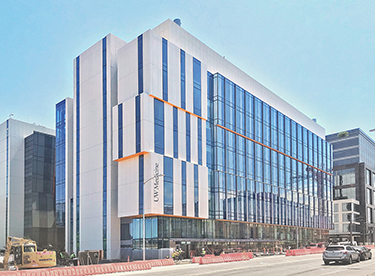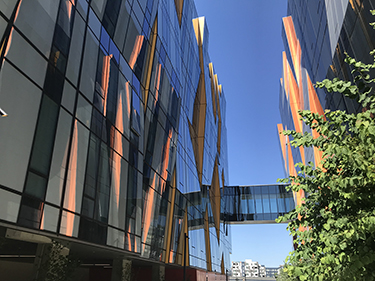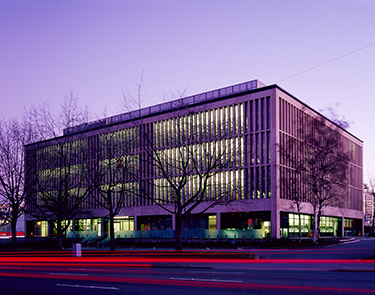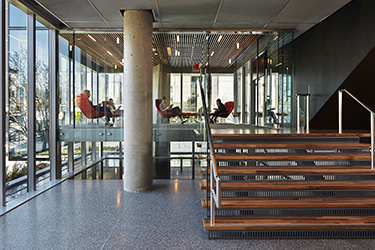|
Subscribe / Renew |
|
|
Contact Us |
|
| ► Subscribe to our Free Weekly Newsletter | |
| home | Welcome, sign in or click here to subscribe. | login |
Construction
| |
 |
August 30, 2018
After two decades, UW’s SLU campus nears completion
Perkins+Will

Gianopoulos
|
Nearly 20 years ago, the University of Washington envisioned a new urban campus for medical research unlike anywhere else in the world.
It would become a hub for the city’s burgeoning biotech sector. It would spark the transformation of a neglected neighborhood into one of the country’s fastest-growing communities. It would set a new architectural aesthetic that would not only be purposeful but beautiful and sustainably driven.
Today, the UW School of Medicine South Lake Union campus is home to thousands of scientists, researchers and staff who work across its various buildings to develop life-changing therapies and cutting-edge medical breakthroughs. It serves as the centerpiece for the city’s biotech industry, surrounded by leading health care and biotech organizations like the Bill & Melinda Gates Foundation, Fred Hutchinson Cancer Research Center, and the Allen Institute.
Public-private delivery
When UW set out to create an academic research complex off its traditional campus and on an accelerated schedule, it needed a different kind of delivery method.
The institution looked to a public-private partnership, or P3, model for its efficiencies in process and in timeline. The School of Medicine selected an integrated P3 team of National Development Council, Vulcan Real Estate, Perkins+Will, Turner Construction Co. (first phase) and Sellen (second and third phases) to master plan, program and design the entire two-block campus.
The team was responsible for delivering more than 1.2 million gross square feet of space and seven buildings over a span of two decades using a model of delivery unique for a project of its kind.
The first phase of the two-block project focused on the south end of campus, renovating the Washington Natural Gas building into a modern biomedical research lab.
Phase two focused on the epicenter of campus, creating a five-story office tower with laboratory and research facilities connected by a new inner courtyard.
The third phase completes the west end with an eight-story building with clinics on the first three levels and research labs on the upper five levels, which is slated to open this fall. Facing Mercer Street, the final building is slated to begin construction in 2020.
The P3 process for phase one and two was so successful — delivered in 36-40 months vs. 48-52 months by conventional methods — that the National Council for Public-Private Partnerships recognized the team for its “innovative approach” to development.
The third phase is also being developed by P3, which like the first two phases is being led by the Perkins+Will team.
Building connections
The campus was designed to bridge connections between buildings, fostering opportunities for collaboration, education and interaction between its researchers and staff.
The design unites biomedical laboratories, bioinformatics labs, genomics research, administrative offices and support spaces across campus. With open floor plates in each building, accessibility is efficient and encourages people from various departments to interact.
Common spaces, conference rooms and break areas are also located on every floor to further encourage collaboration and teaming. All of these factors enrich the workspace and are vital to enabling scientific exploration and research.
At the same time, the design emphasizes integration within the neighborhood and surrounding community through features like a pedestrian-friendly path to the city’s oldest park and a publicly accessible courtyard with a wooded boardwalk and suspended cable lights.
This transparency across the campus earned praise from the American Institute of Architects Washington Council, which noted it “allows for a connection to the environment and vibrant natural light” and seamlessly integrates stunning architecture with community purpose.
A new aesthetic
At the start of design, South Lake Union consisted primarily of dated, single-story manufacturing and automotive buildings.
With a modern design of aluminum, steel and glass, Perkins+Will introduced a new contemporary aesthetic to the neighborhood, and a look quite different from other medical and scientific buildings in the region. The rhythm of glass and aluminum curtain walls creates a modern visual experience unlike anything else in the neighborhood.
While designing a modern aesthetic, the team also introduced a new way of thinking about building performance and sustainability. Green strategies like chilled beams, radiant cooling systems, natural daylighting, exterior sunshades, sustainably harvested wood and low-water-use landscaping are embedded throughout the campus, highlighting the team’s commitment to environmentally conscious design practices.
Once in a lifetime does a project of this caliber come to light, offering the rare opportunity for true transformation. From delivery model and programming to design and construction, innovative strategies were used to meet ambitious goals.
Its vision set into action the development of an emerging neighborhood, creating today what has become an icon of one of the world’s leading scientific communities.
Anthony Gianopoulos is a principal with the Seattle office of Perkins+Will.
Other Stories:
- It's much easier for schools to get to net zero
- How enviro consultants can lend your school project a helping hand
- UW Life Sciences Building: giant firs and bird songs offer a one-of-a-kind elevator ride
- 3 keys to building green schools: design, operations and renewables
- Bremerton alternative school breaks down walls to learning
- Studies suggest design really can affect how well students learn
- The view from inside a school: what really makes it safe
- Eastside Prep’s versatile arts hall made for concerts, plays and yoga
- How playgrounds make all children feel welcome
- See-through schools spark interest in learning
- Schools have more ways than ever to go green
- OSU football center opts for flexible lighting scheme
- Stretch your tight budget by getting creative
- Long-distance teams worked in concert to remake Wyoming school theater






